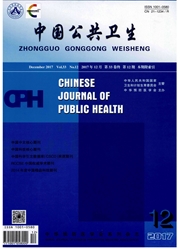

 中文摘要:
中文摘要:
目的研究人类白细胞抗原(HLA)-DR3、DR7、DR13、DR53等位基因与乙型肝炎病毒(Hepatitis Bvirus,HBV)宫内感染的关系,探讨FIBV宫内感染的遗传易感性,确定HBV富内感染的易感基因和保护基因。方法采用聚合酶链反应/序列特异性引物(PCR—SSP)技术检测HBsAg阳性孕妇及其新生儿各187例外周静脉血血块中HLA—DR3、DR7、DR13、DR53等位基因型分布及频率。结果(1)宫内感染组孕妇HLA—DR3基因频率为24.14%(7/29),显著高于非宫内感染组孕妇的6.33%(10/158)(P=0.007)。其余各表型比较,差异无统计学意义(P〉0.05)。(2)宫内感染组新生儿HLA—DR3基因频率为17.24%(5/29)。显著高于非宫内感染组新生儿的5.06%(8/158)(P=0.033)。其余各表型比较,差异无统计学意义(P〉0.05)。(3)母婴HLA—DR3同阳性在宫内感染组与宫内未感染组间比较差异有统计学意义(P=0.049);母婴HLA-DR7、DR13、DR53同阳性在宫内感染组与宫内未感染组间比较。差异无统计学意义(P〉0.05)。结论HBsAg阳性孕妇及其胎儿同时或任一携带HLA—DR3,易导致HBV宫内感染;HLA—DR3是HBV宫内感染的易感基因。
 英文摘要:
英文摘要:
Objective To study the association between HLA- DR3, DR7, DR13, DR53 and HBV intrauterine infection to probe into the susceptibility to intrauterine infection of hepatitis B virus and to find its predisposing genes and protecting genes. Methods HLA - DR3, DR7, DR13, DR53 were detected by the technique of polymerase chain reaction - sequence specific primers(PCR - SSP) in maternal and neonatal blood clot. Results (1) The frequency of HLA - DR was 24.14 96 in women with intrauterine infection, which was higher than that ( 6.33 % ) in women without intrauterine infection ( P = 0. 007). There was no association between HLA- DR7, DR13, DR53 positive in pregnant women and HBV intrauterine infection( P 〉 0.05). (2) The frequency of HLA- R of newborns was 17.24 % in women with intrauterine infection, which is higher that (5.06%) in women withotll infection(P = 0. 033). There was no association between HLA - DR7, DR13, DR53 positive in newborns and HBV intrauterine infection( P 〉 0.05 ). (3) There was significant association between HLA - DR3 concordance and HBVintrauterine infection(P = 0. 049). There was no association between DR7, DR13, DR53 concordance and HBV intrauterine infection(P 〉 0.05 ). Conclusion HLA - DR3 carriers of pregnant women and their newborns have susceptibility to HBV intrauterine infection. HLA- DR3 is the predisposing gene of HBV intrauterine infection.
 同期刊论文项目
同期刊论文项目
 同项目期刊论文
同项目期刊论文
 期刊信息
期刊信息
